| Central | |||||||||||||||
|---|---|---|---|---|---|---|---|---|---|---|---|---|---|---|---|
 Central as viewed from Tsim Sha Tsui, on the opposite side of Victoria Harbour Central as viewed from Tsim Sha Tsui, on the opposite side of Victoria Harbour | |||||||||||||||
| Traditional Chinese | 中環 | ||||||||||||||
| Simplified Chinese | 中环 | ||||||||||||||
| Cantonese Yale | Jūng Wàahn | ||||||||||||||
| |||||||||||||||
Central (Chinese: 中環), also known as Central District, is the central business district of Hong Kong. It is located in the northeastern corner of the Central and Western District, on the north shore of Hong Kong Island, across Victoria Harbour from Tsim Sha Tsui, the southernmost point of Kowloon Peninsula. The area was the heart of Victoria City, although that name is rarely used today.
As the central business district of Hong Kong, it is the area where many multinational financial services corporations have their headquarters. Consulates of many countries are also located in this area, as is Government Hill, the site of the government headquarters until 2011. The area, with its proximity to Victoria Harbour, has served as the centre of trade and financial activities from the earliest days of the British colonial era in 1841, and continues to flourish and serve as the place of administration since the handover to China in 1997.
Naming
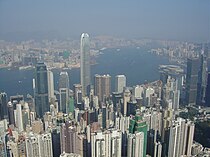 View of Central and Victoria Harbour from Victoria Peak. Tsim Sha Tsui is visible across the harbour.
View of Central and Victoria Harbour from Victoria Peak. Tsim Sha Tsui is visible across the harbour. Admiralty, Central and the Central and Wan Chai Reclamation, view from the east in 2010.
Admiralty, Central and the Central and Wan Chai Reclamation, view from the east in 2010. The General Post Office, the City Hall, and the surrounding business buildings in Central, viewed from the west.
The General Post Office, the City Hall, and the surrounding business buildings in Central, viewed from the west.
The area of Chung Wan (aka Choong Wan in the past; 中環), a direct translation of Central in English, was one of the districts (四環九約) in Victoria City. The English name Central became prevalent after the Island line of the MTR metro system was built in the early 1980s, and the connected stations of Pedder and Chater (named after major streets in the area) were renamed as Central. On some older maps, Central and the area to its west are named Kwan Tai Lo (羣帶路) below Victoria Peak. It formed a channel, Chung Mun (中門), with Tsim Sha Tsui, on the sea route along the coast of southern China. The eastern part of Central District has been known as Admiralty since the completion of Admiralty station in the early 1980s.
Despite the name Central being synonymous with the Central and Western District, and Central station, there are significant differences. Central and Western is a administrative district with strict boundaries, legislative representation, and elections for its legislators. Central station (more commonly referred to as Central) is a stop along the MTR Island Line, but is not the only station within the Central and Western District. Other stops include Hong Kong, Admiralty, Sheung Wan and more. The Central area is a loosely defined area within the Central and Western district defined by the presence of major banks, sky scrapers, and multi-modal transportation nodes.
Location
Central is located on the north shore of Hong Kong Island, across Victoria Harbour from Tsim Sha Tsui, the southernmost point of Kowloon Peninsula. It is bordered in the west by Sheung Wan, with the border being along Aberdeen Street (also called Wing Kut Street). It is bordered in the east by Admiralty, an eastern extension of the Central and Western District. As such, Admiralty is sometimes considered a part of Central. Central is bordered in the south by Mid-Levels, an affluent residential area halfway up Victoria Peak. The boundary between Central and Mid-Levels is not clearly defined.
For district council elections purposes, the area, together with Admiralty, correspond roughly to the "Chung Wan" constituency. The boundaries of such constituencies may be subject to modification.
History


The British landed on Possession Point of Sheung Wan in 1841. They soon decided to build a city on the north coast of Hong Kong Island, and the present-day Central was chosen to house major military facilities and an administrative centre. Part of these military facilities include the Royal Navy port known as Naval Dockyard, and then later Admiralty. Another area to the north of Admiralty would be named Tamar for the HMS Tamar shore station (named for HMS Tamar, a Royal Navy troopship that arrived and was used as a shore base during the second opium war). The area soon attracted both Westerners and Chinese to trade and live in the area, and a Canton Bazaar (the precursor of the Central Market) was built between Cochrane Street and Graham Street in 1842. The area was soon zoned for Westerners only, and Chinese residents were restricted to Sheung Wan. It was zoned for "Western-style buildings," meaning buildings with space requirements and hygiene standards similar to European. The area was largely dominated by the presence of Victoria City. The popularity of this area would also boost the population of Hong Kong from 5,000 in 1841 to 24,000 in 1848. Government House and other Hong Kong Government buildings were completed during this period on Government Hill. Various barracks, naval bases and the residence of the Commander of British Forces in Hong Kong, Flagstaff House were built on the east end of the district. Between 1860 and 1880 the construction of City Hall, Theatre Royal and other financial structures made Central the heart of Hong Kong.
In 1904, the Praya Reclamation Scheme added 59 acres (24 ha) of land to Central's waterfront. Many of the proposals came from Sir Paul Chater and James Johnstone Keswick, the founders of Hongkong Land, a modern property development group. During the 1920s, Hong Kong was able to push far ahead economically, because of the cohesive collaboration between Central and all waterfront commerce.
The military structures survived until the 1980s. Only Flagstaff House remains as Museum of Tea Ware in Hong Kong Park. City Hall sat on the present premises of the HSBC Hong Kong headquarters. Hong Kong's first road, Queen's Road (subdivided into Queen's Road East, Central, and West), passes through the area and the business centre has continued to expand the Hong Kong shoreline into Victoria Harbour. The Hong Kong Garrison was home to the British Forces in Hong Kong, until the handover in 1997, since then it has been occupied by the People's Liberation Army of China.
Central has been the site of a number of major political protests. From October 2011 to September 2012, the Occupy Central movement against global economic inequality was based in front of the HSBC Main Building. Two years later, in September 2014, democratic activists initiated Occupy Central with Love and Peace, demanding universal suffrage for the election of the Chief Executive of Hong Kong, eventually contributing to the Umbrella Revolution.
Economy
| This section needs expansion. You can help by adding to it. (September 2011) |
There are many Grade-A commercial buildings in Central, a prime commercial district in Hong Kong.
Bank of China (Hong Kong) has its head office in the Bank of China Tower. The Hongkong and Shanghai Banking Corporation, a subsidiary of HSBC, has its head office in the HSBC Main Building. Bank of East Asia and Hang Seng Bank have their head offices in Central. Standard Chartered Bank is also located in Central. The Hong Kong Monetary Authority is based in IFC 2. Chu Kong Passenger Transport is headquartered in the Chu Kong Shipping Tower (珠江船務大廈) in Central. The head office of New World Development is in the New World Tower [zh] in Central. HKR International has its head office in Shun Tak Centre.
Before 1999, Cathay Pacific had its head office in the Swire House in Central. In 1999, the airline relocated its head office to the Hong Kong International Airport.
Nord Anglia Education, which operates international schools in various countries, formerly had its head office in Central. The head office moved to Hong Kong in 2012. In 2018 the company announced it was returning its head office to the United Kingdom.
Notable places, streets and buildings
Office buildings


- 9 Queen's Road Central
- Agricultural Bank of China Tower
- AIA Central
- Alexandra House
- Bank of America Tower
- Bank of China Building, housing the China Club
- Bank of China Tower
- Central Building
- Chater House
- Cheung Kong Center
- Cheung Kong Center II
- Citibank Plaza
- CITIC Tower
- Entertainment Building
- Exchange Square, housing the Hong Kong Stock Exchange
- Hong Kong Club Building, housing the Hong Kong Club
- Hong Kong Trade Centre
- HSBC Main Building
- Hutchison House
- Jardine House
- Man Yee Building
- Prince's Building
- St. John's Building
- Standard Chartered Bank Building
- The Center
- The Centrium
- The Henderson
- The Landmark (office and shopping complex)
- International Finance Centre (IFC), the second tallest building in Hong Kong
- Wheelock House
- Wing On House
- World-Wide House
- York House
Streets and squares

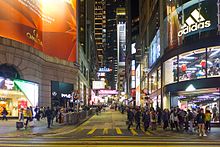
- Aberdeen Street, marking the limit between Central and Sheung Wan
- Arbuthnot Road
- Battery Path
- Chater Road
- Connaught Place
- Cochrane Street
- Connaught Road Central
- Cotton Tree Drive
- D'Aguilar Street
- Des Voeux Road Central
- Edinburgh Place, a public square adjacent to the Victoria Harbour
- Elgin Street
- Gage Street, a market street
- Garden Road
- Glenealy
- Graham Street, a market street
- Gutzlaff Street
- Hollywood Road
- Ice House Street
- Jubilee Street (租庇利街). Named for the Golden Jubilee of Queen Victoria in 1887.
- Lower Albert Road
- Lyndhurst Terrace
- Old Bailey Street
- On Lan Street
- Pedder Street
- Peel Street
- Pottinger Street, one of the "ladder streets"
- Queen's Road Central, the first road in Hong Kong built by the Government of Hong Kong between 1841 and 1843
- Queen Victoria Street
- Queensway, in Admiralty
- Stanley Street
- Statue Square, a public pedestrian square
- Staunton Street
- Staveley Street, one of the "ladder streets"
- Theatre Lane, home to many of Hong Kong's shoe shiners
- Wellington Street
- Wyndham Street
- Wing On Street (永安街), aka. Cloth Street (花布街)
Government buildings
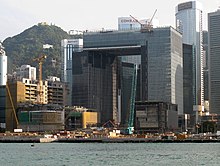



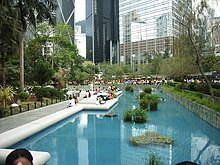
- Central Government Complex, Tamar
- Former Central Government Offices on Government Hill
- Chinese People's Liberation Army Forces Hong Kong Building
- City Hall
- Former French Mission Building, housing the Hong Kong Court of Final Appeal
- General Post Office, Hong Kong
- Government House
- Hong Kong Planning and Infrastructure Exhibition Gallery
- Legislative Council Building
- Queensway Government Offices
Other historical buildings
- Bishop's House
- Central Market
- Central Police Station
- Duddell Street Steps and Gas Lamps
- Flagstaff House
- Former Central Magistracy
- Hong Kong Visual Arts Centre
- Old Dairy Farm Depot, housing the Hong Kong Fringe Club and the Foreign Correspondents' Club
- Pedder Building
- The Cenotaph
- The Helena May main building
- Victoria Prison
- Zetland Hall
- Central and Western Heritage Trail
- Dr Sun Yat-sen Historical Trail
Hotels
Central, together with Tsim Sha Tsui and Tsim Sha Tsui East, is home to many hotels.
- Conrad Hong Kong (Pacific Place, Admiralty)
- Four Seasons Hotel Hong Kong (IFC)
- Hong Kong Hilton (demolished in 1995)
- JW Marriott Hotel Hong Kong (Pacific Place, Admiralty)
- Landmark Mandarin Oriental (The Landmark)
- Mandarin Oriental (Connaught Road Central)
- The Murray, Hong Kong
- Ovolo Hotels (2 Arbuthnot Road). Opened in October 2012.
- Ritz-Carlton (Chater Road), closed 1 January 2008.
- Island Shangri-La (Pacific Place, Admiralty)
Serviced Apartments
It provides alternative options for those who do not want to stay in Hotels, but looking for flexible lease terms, below are some examples:
- Four Seasons Place
- Lily Court Tower 1
- Lily Court Tower 2
- Madera Hollywood
- Shama Central
- Shama Hollywood
- The Staunton
- Townplace Soho
- Yin Serviced Apartments
Entertainment areas
- Lan Kwai Fong, the location of numerous bars, restaurants and clubs
- Hong Kong Maritime Museum, Central Ferry Pier 8
- SoHo, Hong Kong
- Wyndham Street
- Central Harbourfront
- Central Market
- Tai Kwun
- PMQ
Places of worship
- Various Buddhist temples
- St. John's Cathedral (Sheng Kung Hui, Anglican Church)
- First Church of Christ Scientist
- Union Church
- Immaculate Conception Cathedral, Hong Kong (Roman Catholic)
- St. Joseph's Church (Roman Catholic)
Parks

- Chater Garden
- Cheung Kong Park
- Hong Kong Park, former location of the Victoria Barracks
- Hong Kong Zoological and Botanical Gardens
- Statue Square
Schools
- Raimondi College (高主教書院)
- Sacred Heart Canossian School
- St Joseph's College, Hong Kong
- Ying Wa Girls' School (in Mid-Levels)
- St. Paul's Co-educational College (in Mid-Levels)
Central is in Primary One Admission (POA) School Net 11. Within the school net are multiple aided schools (operated independently but funded with government money) and the following government schools: Bonham Road Government Primary School and Li Sing Primary School [zh] (李陞小學).
Former buildings
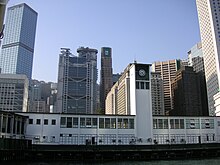
- Beaconsfield House, demolished in 1995
- Hong Kong Hilton, closed in 1995
- Hongkong Hotel, closed in 1952
- Murray House, part of Murray Barracks, moved to Stanley
- Old Central Government Offices, demolished in 1954
- Wellington Barracks, demolished in 1992
- City Hall Ferry Pier, barge pier, closed due to the Central and Wan Chai Reclamation
- Edinburgh Place Ferry Pier, demolished in 2007
- Blake Pier, Central, demolished, partially moved to Stanley
- Queen's Pier, demolished in 2008
- United Pier, demolished in 1994
Transport



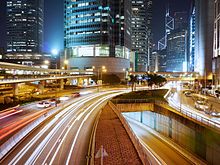
Public transport
The area is a major transport hub for Hong Kong (see also Transport in Hong Kong).
- Bus
- Minibus
- Trains and Trams
- MTR – Island line, Tsuen Wan line, Tung Chung line, Airport Express, South Island line, East Rail line at Sheung Wan, Hong Kong, Central and Admiralty stations
- Tram
- Peak Tram
- Ferries
- Sun Ferry, to Silvermine Bay (Mui Wo), Peng Chau and Cheung Chau
- Hong Kong & Kowloon Ferry, to Sok Kwu Wan and Yung Shue Wan on Lamma Island
- Star Ferry, to Tsim Sha Tsui and Hung Hom
- Discovery Bay Ferry, to Discovery Bay service at Central Pier 3
- Park Island Ferry
- Ferry piers:
- Pedestrian facilities
Expressways and routes
Climate
| Climate data for Hong Kong Park (2011–2020) Extremes (2008–present) Sunshine hours (2019–2023) | |||||||||||||
|---|---|---|---|---|---|---|---|---|---|---|---|---|---|
| Month | Jan | Feb | Mar | Apr | May | Jun | Jul | Aug | Sep | Oct | Nov | Dec | Year |
| Record high °C (°F) | 28.4 (83.1) |
27.9 (82.2) |
30.9 (87.6) |
32.3 (90.1) |
35.8 (96.4) |
34.8 (94.6) |
36.0 (96.8) |
36.1 (97.0) |
35.8 (96.4) |
34.2 (93.6) |
32.0 (89.6) |
29.0 (84.2) |
36.1 (97.0) |
| Mean maximum °C (°F) | 25.3 (77.5) |
26.4 (79.5) |
28.3 (82.9) |
30.4 (86.7) |
33.2 (91.8) |
34.1 (93.4) |
34.8 (94.6) |
35.2 (95.4) |
34.2 (93.6) |
32.1 (89.8) |
29.6 (85.3) |
26.4 (79.5) |
35.5 (95.9) |
| Mean daily maximum °C (°F) | 19.6 (67.3) |
20.0 (68.0) |
22.3 (72.1) |
25.8 (78.4) |
29.0 (84.2) |
31.2 (88.2) |
31.8 (89.2) |
31.8 (89.2) |
31.0 (87.8) |
28.6 (83.5) |
25.5 (77.9) |
21.1 (70.0) |
26.5 (79.7) |
| Daily mean °C (°F) | 16.5 (61.7) |
17.0 (62.6) |
19.4 (66.9) |
22.9 (73.2) |
26.4 (79.5) |
28.5 (83.3) |
28.7 (83.7) |
28.6 (83.5) |
27.8 (82.0) |
25.6 (78.1) |
22.7 (72.9) |
18.0 (64.4) |
23.5 (74.3) |
| Mean daily minimum °C (°F) | 14.3 (57.7) |
14.9 (58.8) |
17.3 (63.1) |
20.8 (69.4) |
24.4 (75.9) |
26.5 (79.7) |
26.5 (79.7) |
26.2 (79.2) |
25.6 (78.1) |
23.4 (74.1) |
20.7 (69.3) |
15.7 (60.3) |
21.4 (70.5) |
| Mean minimum °C (°F) | 8.8 (47.8) |
9.8 (49.6) |
12.8 (55.0) |
16.6 (61.9) |
20.3 (68.5) |
23.7 (74.7) |
24.2 (75.6) |
23.7 (74.7) |
23.5 (74.3) |
19.9 (67.8) |
15.6 (60.1) |
9.7 (49.5) |
7.9 (46.2) |
| Record low °C (°F) | 2.9 (37.2) |
6.7 (44.1) |
8.4 (47.1) |
13.6 (56.5) |
16.7 (62.1) |
20.3 (68.5) |
22.2 (72.0) |
22.6 (72.7) |
22.2 (72.0) |
15.0 (59.0) |
10.0 (50.0) |
5.8 (42.4) |
2.9 (37.2) |
| Mean monthly sunshine hours | 165.1 | 138.7 | 139.7 | 132.5 | 141.6 | 138.9 | 214.3 | 173.7 | 194.8 | 190.1 | 199.5 | 170.8 | 1,999.7 |
| Source: Hong Kong Observatory | |||||||||||||
Trivia
The film The Dark Knight takes place in part in Central, Hong Kong, specifically at the Mid-Levels escalator, on the top of IFC (International Finance Centre) 2, and crashing into IFC 1.
References
- Tsang, Steve (2004). A Modern History of Hong Kong. I.B. Tauris. p. 17. ISBN 1-84511-419-1.
- http://www.legco.gov.hk/yr03-04/chinese/panels/ha/papers/ha0109cb2-2253-1ce.pdf
- https://www.facebook.com/story.php?story_fbid=587897254621475&substory_index=0&id=541641519247049
- Map of circa 1880
- http://www.aab.gov.hk/form/20210315_historic_3_new_items.pdf#page=1 Archived 24 April 2021 at the Wayback Machine
- https://www.amo.gov.hk/form/PMQ-HIA-vol_01-BHIA.pdf
- District Council electoral boundaries – Central and Western District
- Press release: "Public consultation on proposed constituency boundaries for 2011 District Council Election", 3 December 2010
- Sanderson, Edgar (1897–1898). The British Empire in the nineteenth century: its progress and expansion at home and abroad. Vol. IV. London: Blackie and Son. p. 337. LCCN 02002538. OCLC 11625716.
- Wordie, Jason. (2002) Streets: Exploring Hong Kong Island. Hong Kong: Hong Kong University Press. ISBN 962-209-563-1
- Bradsher, Keith (11 September 2012). "Occupy Hong Kong Protesters Forcibly Removed". The New York Times. ISSN 0362-4331. Retrieved 24 October 2023.
- Barber, Elizabeth; Campbell, Charlie (28 September 2014). "Police Fire Tear Gas at Hong Kong Democracy Rally". Time. Retrieved 24 October 2023.
- Office For Rent at Central Treasure Land. Retrieved 3 Oct 2018
- "Contact Us Archived 20 August 2011 at the Wayback Machine." Bank of China. Retrieved on 11 September 2011. "Registered Office BOC Hong Kong (Holdings) Limited 52/F Bank of China Tower 1 Garden Road Hong Kong"
- "Contact Us." HSBC. Retrieved on 12 September 2011. "The Hongkong and Shanghai Banking Corporation Ltd The Hongkong and Shanghai Banking Corporation – Hong Kong Address: GPO Box 64, Hong Kong, 1 Queen's Road Central, Hong Kong SAR, China"
- "Investor Enquiries." Bank of East Asia. Retrieved on 11 September 2011. "Registered Office: 10 Des Voeux Road Central, Central, Hong Kong"
- "Business Banking Centres." Hang Seng Bank. Retrieved on 11 September 2011. "Level 1 & 6, Hang Seng Headquarters, 83 Des Voeux Road, Central" (Map Archived 2 April 2012 at the Wayback Machine)
- "Contact Us". Chu Kong Passenger Transport. Archived from the original on 25 August 2021. Retrieved 25 August 2021.
Company Address: 22/F.,Chu Kong Shipping Tower, 143 Connaught Road Central, Hong Kong
– Traditional Chinese Archived 25 August 2021 at the Wayback Machine: "香港干諾道中一四三號珠江船務大廈22字樓" , Simplified Chinese Archived 25 August 2021 at the Wayback Machine: "香港干诺道中一四三号珠江船务大厦22字楼" - "Contact Us". New World Development. Retrieved 15 September 2022.
30/F, New World Tower, 18 Queen's Road, Central, Hong Kong
– Traditional Chinese address: "香港中環皇后大道中18號新世界大廈30樓", Simplified Chinese address: "香港中环皇后大道中18号新世界大厦30楼" - "Contact Us". HKR International Limited. Retrieved 9 December 2023.
Mail HKR International Limited 23/F, China Merchants Tower Shun Tak Centre 168 Connaught Road Central Hong Kong
- Traditional Chinese: "香港干諾道中168號 信德中心招商局大廈23樓", Simplified Chinese: "香港干诺道中168号 信德中心招商局大厦23楼" - "World Airline Directory" (PDF). Flight International. 30 March 1985. p. 68. Retrieved 17 June 2009. "Head Office: Swire House, 9 Connaught Road, C, Hong Kong"
- "Cathay Pacific wins award for providing a smoke-free workplace at its Hong Kong Headquarters" (Press release). Cathay Pacific. 6 January 2005. Retrieved 2 July 2009.
- "Contact Us." Nord Anglia Education. Retrieved on 5 March 2016. "Central Office Address: Nord Anglia Education St George's Building Level 12 2 Ice House Street Central Hong Kong"
- "Nord Anglia Education Relocates its Global Headquarters to Hong Kong". Nord Anglia Education. 15 January 2012. Retrieved 22 November 2020.
- "Nord Anglia moves HQ to London". The PIE News. Professionals in International Education. 10 October 2018. Retrieved 22 November 2020.
- The Henderson
- Yanne, Andrew; Heller, Gillis (2009). Signs of a Colonial Era. Hong Kong University Press. p. 8. ISBN 978-962-209-944-9.
- Lim, Patricia. (2002). Discovering Hong Hong's Cultural Heritage. Central, Hong Kong: Oxford University Press. ISBN Volume One 0-19-592723-0
- "POA School Net 11" (PDF). Education Bureau. Retrieved 12 September 2022.
- "Monthly Means of Meteorological Elements for The Peak, 2004–2017". Hong Kong Observatory. Retrieved 29 May 2018. 山頂氣象要素月平均值 (2004–2017)
- "Monthly Means of Meteorological Statistics for The Peak, 2004–2017". Hong Kong Observatory. Retrieved 29 May 2018. 山顶气象统计月平均值 (2004–2017)
- "Extreme Values and Dates of Occurrence of Extremes of Meteorological Elements between 1884–1939 and 1947–2017 for Hong Kong". Hong Kong Observatory. Retrieved 29 May 2018.
External links
 Hong Kong/Central travel guide from Wikivoyage
Hong Kong/Central travel guide from Wikivoyage Media related to Central, Hong Kong at Wikimedia Commons
Media related to Central, Hong Kong at Wikimedia Commons- Lastest Guide to Central Hong Kong
- Photo Tour of Central Hong Kong Archived 24 May 2016 at the Wayback Machine, About.com
- Map of Central District in 1964 (crown copyright)
- Map of Hongkong Central 1911
22°16′55″N 114°09′29″E / 22.28194°N 114.15806°E / 22.28194; 114.15806
Portal:| Central and Western District | |||||||
|---|---|---|---|---|---|---|---|
| Main borders and locations | |||||||
| Areas | |||||||
| Education |
| ||||||
| Landmarks |
| ||||||
| Transport |
| ||||||
| History | |||||||
| This list is incomplete. Central has its own template due to the number of sites in that area. Sites specifically associated with University of Hong Kong are listed at the relevant template. | |||||||
| Urban areas of Hong Kong, Kowloon and New Territories | |||||||||||
|---|---|---|---|---|---|---|---|---|---|---|---|
| Hong Kong |
|  | |||||||||
| Kowloon |
| ||||||||||
| New Kowloon |
| ||||||||||
| New Territories |
| ||||||||||
| Official place names are summarized from "Geoinfo Map" of Government of Hong Kong Special Administrative Region, "Hong Kong Guide" of Lands Department, "Hong Kong Guide Book" of Universal Publications Ltd. and "Areas and Districts" of Rating and Valuation Department. M:Narrow meaning of urban areas KL: Kowloon Peninsula at the south of Boundary Street NKL: Former New Territories area at the north of Boundary Street and at the south of Lion Rock 1: Common definition (1) 2: Common definition (2) 3: Common definition (3) 4: Areas not adopting small house concessionary right of indigenous inhabitants 5: Jurisdiction area of former Urban Council 6: Definition of "Metropolitan Area" of Planning Department 7: Jurisdiction area of Urban Renewal Authority 8: Unique operating area of urban taxis 9: "Urban" (9a) and "Extended Urban" (9b) areas defined by Hong Kong Housing Authority 10: Definition of Urban rates 11: Hospital cluster belongs to Hong Kong or Kowloon 12: Police region belongs to Hong Kong or Kowloon 13: Regions having 999-year land lease 14: Geographical Constituency in Hong Kong Legislative Council belongs to Hong Kong or Kowloon 15: Regional Education Office belongs to Hong Kong or Kowloon 16: Primary One Admission School Net belongs to Hong Kong or Kowloon | |||||||||||